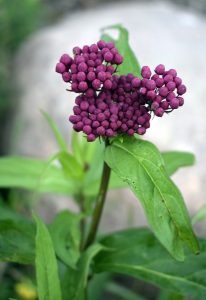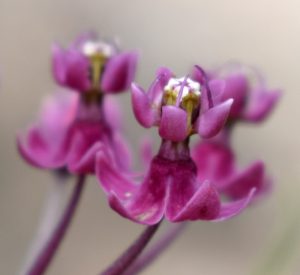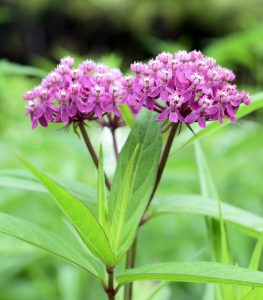Milkweed, Swamp

Asclepia incarnata is one of several milkweeds our region has to choose from, including common, showy, purple, prairie, whorled and butterfly-weed to name a few. All milkweeds have an abundance of sweet nectar attracting a multitude of various species of butterflies and other flying insects — even milkweed-specific beetles — to their nectar-filled and pollen-bearing flowers. Milkweeds are also the sole host plant for the monarch butterfly to lay its eggs on for its cycle of reproduction.
 Swamp milkweed is most easily distinguished from common milkweed by the bright pink petals of its flowers (a bit smaller at 1/4″ wide), and also by its very narrow leaves. For those who love the fascinating world of nature’s unique ways, the close-up world of a swamp milkweed flower cluster is worth mentioning. For starters, the tiny flower itself is quite beautiful and lovely-scented, with five petals curving out at the bottom supporting a crown above with five hoods bearing tempting, nectar-filled cups. Arching up from each hood is a curved, somewhat slippery horn pointed towards the column in the center. It seems to be quite an elaborate design arrangement, and indeed, the inner workings of milkweed flowers — especially the large, ‘showy milkweed’ flower species — can be a downright dangerous place to enter. Insect legs often slip on the horn down into the slit between the nectar-filled cups where the pollen sacs are produced. Of course, that is the entire point from the perspective of the plant’s pollination design. Weaker, smaller insects not strong enough to retract a leg may not come away again with it intact or occasionally be unable to leave the plant at all.
Swamp milkweed is most easily distinguished from common milkweed by the bright pink petals of its flowers (a bit smaller at 1/4″ wide), and also by its very narrow leaves. For those who love the fascinating world of nature’s unique ways, the close-up world of a swamp milkweed flower cluster is worth mentioning. For starters, the tiny flower itself is quite beautiful and lovely-scented, with five petals curving out at the bottom supporting a crown above with five hoods bearing tempting, nectar-filled cups. Arching up from each hood is a curved, somewhat slippery horn pointed towards the column in the center. It seems to be quite an elaborate design arrangement, and indeed, the inner workings of milkweed flowers — especially the large, ‘showy milkweed’ flower species — can be a downright dangerous place to enter. Insect legs often slip on the horn down into the slit between the nectar-filled cups where the pollen sacs are produced. Of course, that is the entire point from the perspective of the plant’s pollination design. Weaker, smaller insects not strong enough to retract a leg may not come away again with it intact or occasionally be unable to leave the plant at all.
 That said, July and August, dozens of ants continually move about each vibrant flower cluster to the background hum of various flying insects going about their busy activity. The irresistible, sugary snack buffet seems well worth the risk. Another unique trait shared among milkweed flowers is that the pollen is not loose but rather delivered in waxy sacs (pollinia). Butterflies lack the equipment to gather pollen in any real sense, and are more feeders here than they are pollinators. As such, they do not fall prey to milkweed’s ensnarement arrangement like other insects might, but merely land lightly upon a flower, insert their long proboscis, and slurp up the welcome carbohydrate drink waiting within.
That said, July and August, dozens of ants continually move about each vibrant flower cluster to the background hum of various flying insects going about their busy activity. The irresistible, sugary snack buffet seems well worth the risk. Another unique trait shared among milkweed flowers is that the pollen is not loose but rather delivered in waxy sacs (pollinia). Butterflies lack the equipment to gather pollen in any real sense, and are more feeders here than they are pollinators. As such, they do not fall prey to milkweed’s ensnarement arrangement like other insects might, but merely land lightly upon a flower, insert their long proboscis, and slurp up the welcome carbohydrate drink waiting within.
